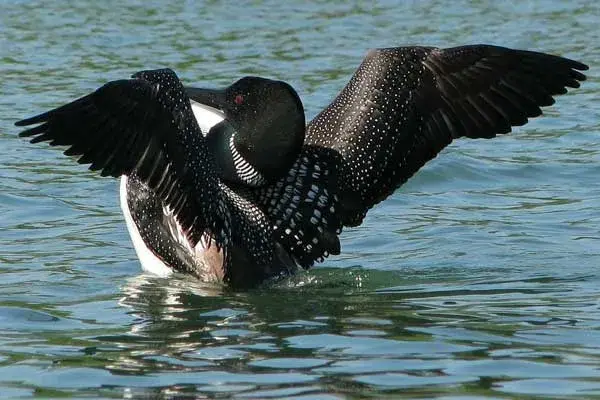Loons are water birds that only go ashore to mate and incubate eggs. They are the size of a big duck or a small goose, but their feet are farther back on the body. They also have longer beaks and sit lower in the water than ducks do.
There are two species of loons that can be spotted in Michigan: the Red-throated Loon and the Common Loon. Red-throated loons can be only seen migrating through Michigan while the Common loons spend summers in the state.
Table of Contents
Loons In Michigan
1. Common Loon

Scientific name: Gavia immer
Lifespan: 20-30 years
Wingspan: 50-57.8 in
Length: 26-36 in
Weight: 4.9-16.8 lb
Range In Michigan: Summer resident in Michigan’s Upper Peninsula and Northern Lower Peninsula
This is the largest species of loon found in Michigan and is also known as the great northern diver.
The common loon breeds mostly in the Upper Peninsula and the very northern portions of the Lower Peninsula. There is a very small population of common loons in the southern portions of Michigan’s Lower Peninsula.
Loons usually arrive in Michigan around April and begin preparing their nest in May. They are listed as a threatened species in Michigan and according to the Michigan Breeding Bird Atlas, there are 500 to 775 breeding pairs in the state.
You will easily spot this large diving waterbird by the rounded head and dagger-like beak. The common loon is famous for its eerie, beautiful calls (the wail, tremolo, yodel, and hoot).
During summer, adults have black heads and bills, white breast color, and black-and-white spots on their backs. By the time these loons reach south, the dramatic black and white colors will change into a winter plumage of dull dark gray with white on the front of the neck and breast.
Common loons are excellent divers that can stealthily submerge without a splash to catch fish. They can go over 200 feet below the water’s surface, stay there for up to 5 minutes, and swallow their prey underwater.
Common loons mostly feed on fish, crustaceans, insect larvae, mollusks, and occasionally aquatic plants.
They are monogamous and the pair may breed together for a decade or more. Both the male and the female will often together defend a territory.
The common loon is a state bird of Minnesota, a provincial bird of Ontario (Canada), and one of 5 species of loon found in Canada.
2. Red-throated Loon

Scientific name: Gavia stellata
Lifespan: up to 23 years
Wingspan: 36-47 in
Length: 22-26 in
Weight: 2.2–6.0 lb
Range In Michigan: Migrating through Michigan
Common loon’s close relative, the red-throated loon, can be also seen occasionally in Michigan. It breeds in northern parts of the continent and when the colder weather comes, this loon will migrate to winter along North American coastlines.
The red-throated loon likes to stop on large inland lakes during migration, particularly in autumn.
If you live near Lake Michigan, Lake Superior, Lake Huron, and other Michigan’s larger lakes, you will have a good chance of spotting a red-throated loon.
Look for large flocks and mixes of several loon species, and pay close attention to birds with slender shapes and bill-up postures.
This migratory aquatic bird is found in the northern hemisphere and weighs 4 lbs on average which makes it the smallest and lightest species of loons.
Also considered one of the most graceful of all loons, the red-throated loon is easy to identify by the long gray and red neck, a thin daggerlike beak, narrow hear, and long, pointed wings.
Red-throated loon will often hold its dark beak upward while swimming and got its name from the distinctive reddish throat patch it develops during the breeding season.
It is among the finest fish hunters in North America, but will also eat some amphibians, invertebrates, and plants.
Red-throated loons are monogamous birds that form long-term bonds, and both partners will help build the nest, incubate the eggs, and take care of the young. Unlike other loons, red-throated ones do not carry their young on their backs.
Red-throated loons breed at high latitudes, nest in low densities on small ponds in coastal tundra ecosystems, and spend the majority of the remaining year (around 8 months) on coastal marine waters.
One 2018 study on migration patterns of red-throated loons discovered that on average, these birds will undergo almost 4,000 mile-long fall and spring migrations.
Read More: Examples of songbirds of Michigan
Summary
This concludes our list of loons in Michigan.
Michigan is home to several types of loons that look pretty similar. Loon species in Michigan include the recognizable black and white Common Loon and the elegant Red-throated Loon. Common loons can be seen only during summer in the state, while the red-throated loons will only migrate through the Mitten State.
The other three species of North America’s loons are the Pacific Loon, Yellow-billed Loon, and Arctic Loon – none of them can be seen in Michigan.
People often mistake them for ducks – the main differences are that loons have feet that are farther back on their bodies, have longer bills, and sit lower in the water than ducks do.
These birds can be good indicators of how healthy the environment is. If loons have a healthy population and successfully produce young, this usually means that the environment is healthy.
Next time, should you see these birds in person, you should be able to recognize any of them with ease!
And if you enjoyed our article, here’s another popular read on birds of Michigan: 15+ largest birds you can see in Michigan